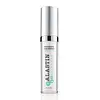What's inside
What's inside
 Key Ingredients
Key Ingredients

No key ingredients
 Benefits
Benefits

 Concerns
Concerns

 Ingredients Side-by-side
Ingredients Side-by-side

Water
Skin ConditioningGlycerin
HumectantPropanediol
SolventNiacinamide
SmoothingIsopropyl Palmitate
EmollientPolyacrylate-13
Butylene Glycol
HumectantPalmitoyl Hexapeptide-12
Skin ConditioningPalmitoyl Tripeptide-1
Skin ConditioningPalmitoyl Tripeptide-5
Skin ConditioningPalmitoyl Dipeptide-5 Diaminobutyroyl Hydroxythreonine
Skin ConditioningPalmitoyl Dipeptide-5 Diaminohydroxybutyrate
Skin ConditioningAcetyl Hexapeptide-38
Skin ConditioningAscorbyl Palmitate
AntioxidantSwertia Chirata Extract
HumectantHydrolyzed Pea Protein
EmollientOrnithine
Skin ConditioningCeramide NP
Skin ConditioningErgothioneine
AntioxidantDunaliella Salina Extract
Skin ConditioningPhytosterols
Skin ConditioningPhospholipids
Skin ConditioningGlycolipids
Skin ConditioningTremella Fuciformis Sporocarp Extract
AntioxidantOlea Europaea Fruit Oil
MaskingGlycine Soja Oil
EmollientButyrospermum Parkii Butter
Skin ConditioningBetaine
HumectantSqualane
EmollientLecithin
EmollientCaprylyl Methicone
Skin ConditioningDisodium EDTA
Polysorbate 20
EmulsifyingTocopherol
AntioxidantCaprylyl Glycol
EmollientCaprylhydroxamic Acid
Polyisobutene
Potassium Sorbate
PreservativeLevulinic Acid
PerfumingSodium Hydroxide
BufferingHelianthus Annuus Seed Oil
EmollientP-Anisic Acid
MaskingSorbitan Isostearate
EmulsifyingEthylhexylglycerin
Skin ConditioningPhenoxyethanol
PreservativeWater, Glycerin, Propanediol, Niacinamide, Isopropyl Palmitate, Polyacrylate-13, Butylene Glycol, Palmitoyl Hexapeptide-12, Palmitoyl Tripeptide-1, Palmitoyl Tripeptide-5, Palmitoyl Dipeptide-5 Diaminobutyroyl Hydroxythreonine, Palmitoyl Dipeptide-5 Diaminohydroxybutyrate, Acetyl Hexapeptide-38, Ascorbyl Palmitate, Swertia Chirata Extract, Hydrolyzed Pea Protein, Ornithine, Ceramide NP, Ergothioneine, Dunaliella Salina Extract, Phytosterols, Phospholipids, Glycolipids, Tremella Fuciformis Sporocarp Extract, Olea Europaea Fruit Oil, Glycine Soja Oil, Butyrospermum Parkii Butter, Betaine, Squalane, Lecithin, Caprylyl Methicone, Disodium EDTA, Polysorbate 20, Tocopherol, Caprylyl Glycol, Caprylhydroxamic Acid, Polyisobutene, Potassium Sorbate, Levulinic Acid, Sodium Hydroxide, Helianthus Annuus Seed Oil, P-Anisic Acid, Sorbitan Isostearate, Ethylhexylglycerin, Phenoxyethanol
Human Neonatal Fibroblast Conditioned Media
Skin ConditioningIsoceteth-20
EmulsifyingEthoxydiglycol
HumectantAcrylates/C10-30 Alkyl Acrylate Crosspolymer
Emulsion StabilisingAminomethyl Propanol
BufferingDisodium EDTA
Ethylhexylglycerin
Skin ConditioningGlycerin
HumectantCaprylyl Glycol
EmollientCaprylhydroxamic Acid
Phenoxyethanol
PreservativeParfum
MaskingHydroxycitronellal
PerfumingLinalool
PerfumingCoumarin
PerfumingAlpha-Isomethyl Ionone
PerfumingGeraniol
PerfumingIsoeugenol
PerfumingHuman Neonatal Fibroblast Conditioned Media, Isoceteth-20, Ethoxydiglycol, Acrylates/C10-30 Alkyl Acrylate Crosspolymer, Aminomethyl Propanol, Disodium EDTA, Ethylhexylglycerin, Glycerin, Caprylyl Glycol, Caprylhydroxamic Acid, Phenoxyethanol, Parfum, Hydroxycitronellal, Linalool, Coumarin, Alpha-Isomethyl Ionone, Geraniol, Isoeugenol
 Reviews
Reviews

Ingredients Explained
These ingredients are found in both products.
Ingredients higher up in an ingredient list are typically present in a larger amount.
Caprylhydroxamic Acid is a chelating agent.
Chelating agents help prevent metal ions from binding to other ingredients. This helps prevent unwanted reactions and effects from using the product.
Caprylhydroxamic Acid is often used with natural antimicrobial products as an alternative to preservatives.
Learn more about Caprylhydroxamic AcidCaprylyl Glycol is a humectant and emollient, meaning it attracts and preserves moisture.
It is a common ingredient in many products, especially those designed to hydrate skin. The primary benefits are retaining moisture, skin softening, and promoting a healthy skin barrier.
Though Caprylyl Glycol is an alcohol derived from fatty acids, it is not the kind that can dry out skin.
This ingredient is also used as a preservative to extend the life of products. It has slight antimicrobial properties.
Learn more about Caprylyl GlycolDisodium EDTA plays a role in making products more stable by aiding other preservatives.
It is a chelating agent, meaning it neutralizes metal ions that may be found in a product.
Disodium EDTA is a salt of edetic acid and is found to be safe in cosmetic ingredients.
Learn more about Disodium EDTAEthylhexylglycerin (we can't pronounce this either) is commonly used as a preservative and skin softener. It is derived from glyceryl.
You might see Ethylhexylglycerin often paired with other preservatives such as phenoxyethanol. Ethylhexylglycerin has been found to increase the effectiveness of these other preservatives.
Glycerin is already naturally found in your skin. It helps moisturize and protect your skin.
A study from 2016 found glycerin to be more effective as a humectant than AHAs and hyaluronic acid.
As a humectant, it helps the skin stay hydrated by pulling moisture to your skin. The low molecular weight of glycerin allows it to pull moisture into the deeper layers of your skin.
Hydrated skin improves your skin barrier; Your skin barrier helps protect against irritants and bacteria.
Glycerin has also been found to have antimicrobial and antiviral properties. Due to these properties, glycerin is often used in wound and burn treatments.
In cosmetics, glycerin is usually derived from plants such as soybean or palm. However, it can also be sourced from animals, such as tallow or animal fat.
This ingredient is organic, colorless, odorless, and non-toxic.
Glycerin is the name for this ingredient in American English. British English uses Glycerol/Glycerine.
Learn more about GlycerinPhenoxyethanol is a preservative that has germicide, antimicrobial, and aromatic properties. Studies show that phenoxyethanol can prevent microbial growth. By itself, it has a scent that is similar to that of a rose.
It's often used in formulations along with Caprylyl Glycol to preserve the shelf life of products.